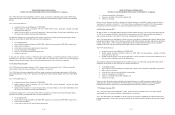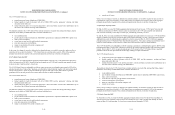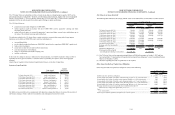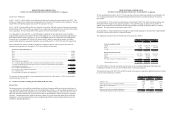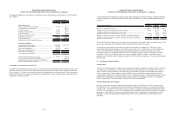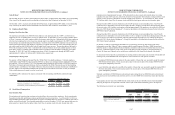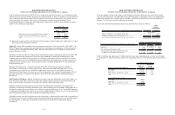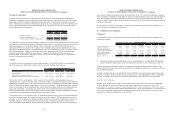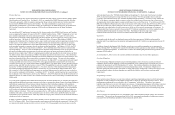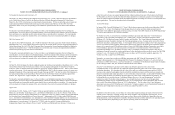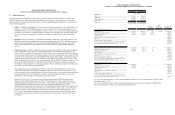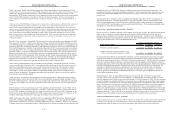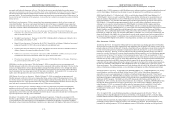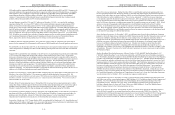Dish Network 2012 Annual Report Download - page 82
Download and view the complete annual report
Please find page 82 of the 2012 Dish Network annual report below. You can navigate through the pages in the report by either clicking on the pages listed below, or by using the keyword search tool below to find specific information within the annual report.DISH NETWORK CORPORATION
NOTES TO CONSOLIDATED FINANCIAL STATEMENTS - Continued
Wireless Spectrum
On March 2, 2012, the FCC approved the transfer of 40 MHz of 2 GHz wireless spectrum licenses held by DBSD
North America and TerreStar to us. On March 9, 2012, we completed the DBSD Transaction and the TerreStar
Transaction, pursuant to which we acquired, among other things, certain satellite assets and wireless spectrum
licenses held by DBSD North America and TerreStar. The total consideration to acquire these assets was
approximately $2.860 billion. This amount includes $1.364 billion for the DBSD Transaction, $1.382 billion for
the TerreStar Transaction, and the net payment of $114 million to Sprint pursuant to the Sprint Settlement
Agreement.
Our consolidated FCC applications for approval of the license transfers from DBSD North America and TerreStar
were accompanied by requests for waiver of the FCC’s Mobile Satellite Service (“MSS”) “integrated service” and
spare satellite requirements and various technical provisions. The FCC denied our requests for waiver of the
integrated service and spare satellite requirements but did not initially act on our request for waiver of the various
technical provisions. On March 21, 2012, the FCC released a Notice of Proposed Rule Making (“NPRM”)
proposing the elimination of the integrated service, spare satellite and various technical requirements attached to the
2 GHz licenses. On December 11, 2012, the FCC approved rules that eliminated these requirements and gave
notice of its proposed modification of our 2 GHz authorizations to, among other things, allow us to offer single-
mode terrestrial terminals to customers who do not desire satellite functionality. On February 15, 2013, the FCC
issued an order, which will become effective on March 7, 2013, modifying our 2 GHz licenses to add terrestrial
operating authority. The FCC’s order of modification has imposed certain limitations on the use of a portion of this
spectrum, including interference protections for other spectrum users and power and emission limits that we
presently believe could render 5 MHz of our uplink spectrum effectively unusable for terrestrial services and limit
our ability to fully utilize the remaining 15 MHz of our uplink spectrum for terrestrial services. These limitations
could, among other things, impact the finalization of technical standards associated with our wireless business, and
may have a material adverse effect on our ability to commercialize these licenses. The new rules also mandate
certain interim and final build-out requirements for the licenses. By March 2017, we must provide terrestrial signal
coverage and offer terrestrial service to at least 40% of the aggregate population represented by all of the areas
covered by the licenses (the “2 GHz Interim Build-out Requirement”). By March 2020, we must provide terrestrial
signal coverage and offer terrestrial service to at least 70% of the population in each area covered by an individual
license (the “2 GHz Final Build-out Requirement”). If we fail to meet the 2 GHz Interim Build-out Requirement,
the 2 GHz Final Build-out Requirement will be accelerated by one year, from March 2020 to March 2019. If we
fail to meet the 2 GHz Final Build-out Requirement, our terrestrial authorization for each license area in which we
fail to meet the requirement will terminate. In addition, the FCC is currently considering rules for a spectrum band
that is adjacent to our 2 GHz licenses, known as the “H Block.” If the FCC adopts rules for the H block that do not
adequately protect our 2 GHz licenses, there could be a material adverse effect on our ability to commercialize the 2
GHz licenses.
As a result of the completion of the DBSD Transaction and the TerreStar Transaction, we will likely be required to
make significant additional investments or partner with others to, among other things, finance the commercialization
and build-out requirements of these licenses and our integration efforts including compliance with regulations
applicable to the acquired licenses. Depending on the nature and scope of such commercialization, build-out, and
integration efforts, any such investment or partnership could vary significantly. Additionally, recent consolidation
in the wireless telecommunications industry, may, among other things, limit our available options, including our
ability to partner with others. There can be no assurance that we will be able to develop and implement a business
model that will realize a return on these spectrum licenses or that we will be able to profitably deploy the assets
represented by these spectrum licenses, which may affect the carrying value of these assets and our future financial
condition or results of operations.
In 2008, we paid $712 million to acquire certain 700 MHz wireless spectrum licenses, which were granted to us by
the FCC in February 2009. These licenses mandate certain interim and final build-out requirements. By June 2013,
we must provide signal coverage and offer service to at least 35% of the geographic area in each area covered by
F-54
DISH NETWORK CORPORATION
NOTES TO CONSOLIDATED FINANCIAL STATEMENTS - Continued
F-55
each individual license (the “700 MHz Interim Build-out Requirement”). By the end of our license term (June
2019), we must provide signal coverage and offer service to at least 70% of the geographic area in each area
covered by each individual license (the “700 MHz Final Build-out Requirement”). We have recently notified the
FCC of our plans to commence signal coverage in select cities within certain of these areas, but we have not yet
developed plans for providing signal coverage and offering service in all of these areas. If we fail to meet the 700
MHz Interim Build-out Requirement, the term of our licenses will be reduced, from June 2019 to June 2017, and we
could face possible fines and the reduction of license area(s). If we fail to meet the 700 MHz Final Build-out
Requirement, our authorization for each license area in which we fail to meet the requirement will terminate. To
commercialize these licenses and satisfy the associated FCC build-out requirements, we will be required to make
significant additional investments or partner with others. Depending on the nature and scope of such
commercialization and build-out, any such investment or partnership could vary significantly.
Guarantees
In connection with the Spin-off, we distributed certain satellite lease agreements to EchoStar and remained the
guarantor under those capital leases for payments totaling approximately $111 million over approximately the next 26
months.
In addition, during the third quarter 2009, EchoStar entered into a new satellite transponder service agreement for
Nimiq 5 through 2024. We sublease this capacity from EchoStar and also guarantee a certain portion of its obligation
under this agreement through 2019. As of December 31, 2012, the remaining obligation under this agreement is the
guarantee of $438 million.
As of December 31, 2012, we have not recorded a liability on the balance sheet for any of these guarantees.
Purchase Obligations
Our 2013 purchase obligations primarily consist of binding purchase orders for receiver systems and related
equipment, digital broadcast operations, satellite and transponder leases, engineering and for products and services
related to the operation of our DISH branded pay-TV service. Our purchase obligations also include certain
guaranteed fixed contractual commitments to purchase programming content. Our purchase obligations can
fluctuate significantly from period to period due to, among other things, management’s control of inventory levels,
and can materially impact our future operating asset and liability balances, and our future working capital
requirements.
Programming Contracts
In the normal course of business, we enter into contracts to purchase programming content in which our payment
obligations are fully contingent on the number of subscribers to whom we provide the respective content. These
programming commitments are not included in the “Commitments” table above. The terms of our contracts
typically range from one to ten years with annual rate increases. Our programming expenses will continue to increase
to the extent we are successful growing our subscriber base. In addition, our margins may face further downward
pressure from price increases and the renewal of long term programming contracts on less favorable pricing terms.
Rent Expense
Total rent expense for operating leases was $399 million, $411 million and $263 million in 2012, 2011 and 2010,
respectively. The increase in rent expense from 2010 to 2011 was primarily attributable to building rent expense
associated with our Blockbuster operations which commenced April 26, 2011.



